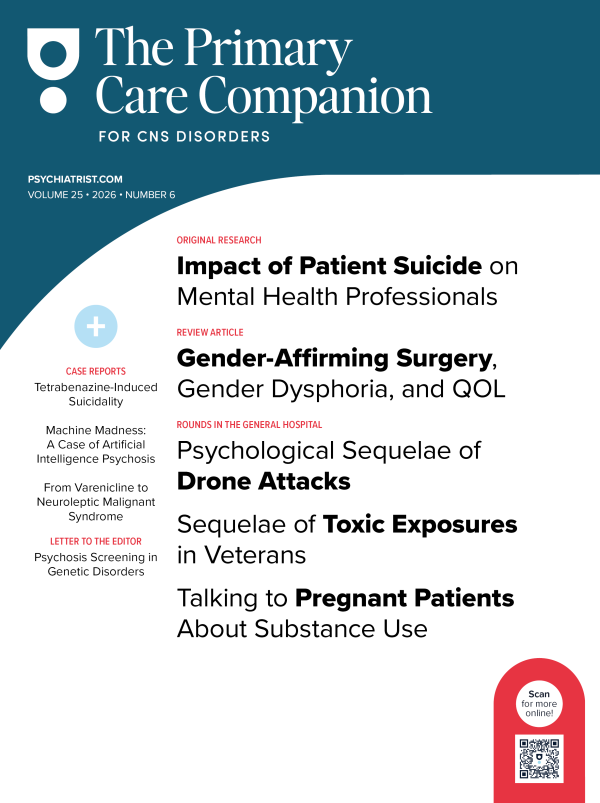Nitrous oxide (N2O), also known as “laughing gas,” is a colorless, nonirritating gas frequently used as an inhaled anesthetic, analgesic, and anxiolytic. However, recreational use and abuse is becoming more prevalent.1 We present the case of a patient with a significant history of ketamine and N2O addiction, which is a relatively rare combination of substances. Her treatment was complicated by a range of neurological, neuropsychiatric, and psychiatric symptoms.
Case Report
A 31-year-old white woman with a psychiatric history of ketamine and N2O addiction presented to the addiction center for treatment. She reported symptoms consistent with peripheral neuropathy (numbness and tingling) and ataxia. She was experiencing malaise, fatigue, insomnia, and muscle soreness. Her use of N2O started 8 years ago with a maximum of 6 bottles daily for the last few years. Her current described use was 1 bottle (580 g) daily. She reported a 10-year history of ketamine abuse with nasal administration of up to 1 g daily. The patient was heavily using in the evening after work, which would continue until she experienced a blackout or seizures. The urine drug screen on presentation could not test for N2O.
She had a history of multiple medical complications felt to be related to her substance use, including seizures related to N2O overdose, impaired cognition, hallucinations, multiple falls, respiratory distress, gastritis, and hematemesis. She also had a history of depression, generalized anxiety disorder, and physical abuse. She reported untreated depression that started before the drug use started. She had never attempted formal rehabilitation or received any medical treatment. She had previously been hospitalized due to suicidal ideations and 1 suicide attempt at age 13 years. In the past, she received cognitive-behavioral therapy and dialectical behavior therapy, which she found helpful. She was prescribed both sertraline and duloxetine but did not take either for over 2 months. On physical examination, she had loss of sensation in her lower extremities and some facial excoriations due to inhalation and ataxia.
Inpatient treatment was recommended, but the patient declined admission. Counseling and psychotherapy were recommended. She started gabapentin 100 mg and naltrexone 50 mg at bedtime to curb cravings. She was initiated on monthly B12 injections. At the follow-up visit, she had only used N2O on 1 occasion. Her neuropathy and ataxia had improved with the initiation of gabapentin. Gabapentin was subsequently increased to 100 mg 3 times daily.
Discussion
There is an under-identified trend of N2O use worldwide. In Britain, the lifetime prevalence of N2O use was 38.6% according to the Global Drug Survey conducted in 2014.2 Overall use has been noted to be increasing, especially in western European countries.2 Sources of N2O are often commonplace and easily obtainable. It is legal in the United States to purchase lesser amounts of the gas to make whipped cream, but not for inhalation or selling.3 The ease of N2O access is particularly problematic, as the general market remains highly unregulated.4 In fact, dozens of canisters containing N2O can be purchased at stores or online.5 Cannisters are also sold and marketed under the guise of use for making homemade whipped cream, but the substance is commonly sold in places that carry no food or drink products, such as smoke shops.6 Furthermore, this ease of access has contributed to an increase in use, as the Substance Abuse and Mental Health Services Administration reported over 12 million N2O users in 2018.7 Ominously, usage increased most among adolescents and young adults, reportedly due to a lack of perceived negative health consequences associated with the drug, as well as the ease of access.7
However, the deleterious effects of N2O are well founded and published. Short-term effects include hallucinations, hyper/hyporeflexia, anxiety, depression, sleep disturbances, and cognitive dysfunction.8 Long-term use will cause chronic length-dependent polyneuropathy, especially found in the lower limbs, with some patients displaying stocking and glove pattern.9 This effect is thought, in part, to be due to the deactivation of cobalamin, by altering cobalt from the Co1+ form to a Co2+ form, irreversibly inactivating cobalamin, which leads to demyelination and paresthesia.8,10 There were also reports of motor and sensory nerve injury that was more common in the lower limbs. These patterns can mimic Guillain-Barré syndrome and need to be differentiated, as N2O inhalation injury is much less common.9,10 Long-term use of N2O and subsequent B12 deficiency can also lead to myelopathy, as well as the previously mentioned neuropathy. In a French study of 181 participants who averaged 1,200 g (about 2.65 lb) of N2O use per day, 37% presented with myelopathy, 38% presented with mixed neurological damage, and 37% had neuropathy.11
N2O is commonly used for anesthesia, and when used for this purpose, approximately 25% of the mixture is N2O, and when used for the hypnotic/narcotic effect, approximately 60%–70% is N2O.12 One proposed mechanism of action is the partial opioid activation on the κ receptor. This mechanism leads to inhibition of the γ-aminobutyric acid (GABA) neurons, which normally inhibit the nonandrogenic pathway. This cascade of events leads to the partial pain relief found with inhalation.9,10
When N2O is inhaled, it works as an N-methyl-D-aspartate antagonist, which can mimic the mechanism of action of ketamine. Similar action allows for the disassociation and heighted senses that can also be associated with ketamine. The disinhibition of GABA in the central nervous system allows for dopamine to be released and the associated feelings of euphoria. This also leads to the activation of the nucleus accumbens, which is associated with pleasure, and the subsequent reward and positive reinforcement of euphoria.9,10
These effects are quickly reversed by stopping inhalation of N2O, as the half-life of the substance is approximately 5 minutes. This quick turnaround also causes a strong positive reinforcement, as frequent inhalation leads to positive feelings for a short time, often necessitating constant and heavy use of the substance for prolonged feelings of euphoria.13,14
Conclusion
N2O is rapidly becoming a more common substance associated with substance use disorder, with the prevalence increasing worldwide. Its gray area legality and consequent availability, in addition to a relatively low cost, make procurement of N2O an easy and safe process. Increasing awareness of N2O substance use is important for clinicians, as the short-lived narcotic effect of N2O leads individuals to consume the substance heavily and frequently, which directly causes harmful long-term consequences, such as a profound B12 deficiency and associated symptoms of neuropathy, myelopathy, and mixed neurological damage.
Article Information
Published Online: July 3, 2025. https://doi.org/10.4088/PCC.24cr03910
© 2025 Physicians Postgraduate Press, Inc.
Prim Care Companion CNS Disord 2025;27(4):24cr03910
Submitted: December 27, 2024; accepted February 11, 2025.
To Cite: Asaukas R, Silvey S, Habibullah Z, et al. Nitrous oxide and ketamine use producing ataxia and neuropathy: a clinical case report. Prim Care Companion CNS Disord 2025;27(4):24cr03910.
Author Affiliations: University of Kansas Medical Center (Asaukas, Silvey, Friesen); Department of Psychiatry and Behavioral Sciences, University of Kansas Medical Center, Kansas City, Kansas (Habibullah, Sethi); Department of Addiction Psychiatry, University of Kansas Health System, Kansas City, Kansas (Habibullah, Sethi).
Corresponding Author: Roopa Sethi, MD, Department of Psychiatry and Behavioral Sciences, University of Kansas Health System, 3901 Rainbow Blvd, Kansas City, KS 66103 ([email protected]).
Relevant Financial Relationships: None.
Funding/Support: Supported by the Department of Psychiatry and Behavioral Sciences, University of Kansas Medical Center and the Department of Addiction Psychiatry, University of Kansas Health System, Kansas City, Kansas.
Role of the Sponsor: The supporters had no role in the design, analysis, interpretation, or publication of this report.
Patient Consent: Consent was received from the patient to publish the case report, and information has been de identified to protect patient anonymity.
References (14)

- Xiang Y, Li L, Ma X, et al. Recreational nitrous oxide abuse: prevalence, neurotoxicity, and treatment. Neurotox Res. 2021;39(3):975–985. PubMed CrossRef
- Kaar SJ, Ferris J, Waldron J, et al. Up: the rise of nitrous oxide abuse. An international survey of contemporary nitrous oxide use. J Psychopharmacol. 2016;30(4):395–401. PubMed CrossRef
- Allan J, Cameron J, Bruno J. A systematic review of recreational nitrous oxide use: implications for policy, service delivery, and individuals. Int J Environ Res Public Health. 2022;19(18):11567. PubMed CrossRef
- Samia AM, Nenow J, Price D. Subacute combined degeneration secondary to nitrous oxide abuse: quantification of use with patient follow-up. Cureus. 2020;12(10):e11041. PubMed CrossRef
- Mustafa A, Wood DM, Dargan PI. Recreational nitrous oxide use and its clinical implications Medicine. Medicine. 2024;52(10):637–642. CrossRef
- Al-Sadawi M, Claris H, Archie C, et al. Inhaled nitrous oxide ‘whip-its!’ causing subacute combined degeneration of spinal cord. Am J Med Case Rep. 2018;6(12):237–240.
- George O. Whip It Drug: Nitrous Oxide Whippits Abuse - No Laughing Matter. Addiction Resource; 2024. https://addictionresource.com/drugs/inhalants/whip-its/
- Johnsen KG. Nitrous oxide safety. J Am Dent Assoc. 1997;128(8):1066–1067. PubMed CrossRef
- Paulus MC, Wijnhoven AM, Maessen GC, et al. Does vitamin B12 deficiency explain psychiatric symptoms in recreational nitrous oxide users? A narrative review. Clin Toxicol. 2021;59(11):947–955. PubMed CrossRef
- van Amsterdam J, Nabben T, van den Brink W. Recreational nitrous oxide use: prevalence and risks. Regul Toxicol Pharmacol. 2015;73(3):790–796. PubMed CrossRef
- Brunt TM, van den Brink W, van Amsterdam J. Mechanisms involved in the neurotoxicity and abuse liability of nitrous oxide: a narrative review. Int J Mol Sci. 2022;23(23):14747. PubMed CrossRef
- Dawudi Y, Azoyan L, Broucker TDE, et al. Marked increase in severe neurological disorders after nitrous oxide abuse: a retrospective study in the Greater Paris area. J Neurol. 2024;271(6):3340–3346. PubMed CrossRef
- Gernez E, Lee GR, Niguet J-P, et al. Nitrous oxide abuse: clinical outcomes, pharmacology, pharmacokinetics, toxicity, and impact on metabolism. Toxics. 2023;11(12):962. PubMed CrossRef
- Dohrn CS, Lichtor JL, Coalson DW, et al. Reinforcing effects of extended inhalation of nitrous oxide in humans. Drug Alcohol Depend. 1993;31(3):265–280. PubMed CrossRef
Please sign in or purchase this PDF for $40.





